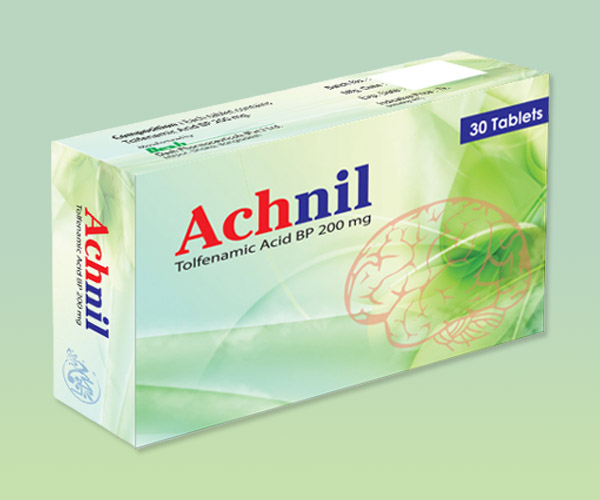Achnil
Tolfenamic Acid
Achnil
Tolfenamic Acid
Presentation
Achnil Tablet: Each tablet contains Tolfenamic Acid BP 200 mg.
Description
Tolfenamic Acid is an NSAID with anti-inflammatory, analgesic and antipyretic effects. It is a prostaglandin synthesis inhibitor and a leukotriene synthesis inhibitor.
- AVAILABILITY: AVAILABLE
Mode of action
NSAIDs like tolfenamic acid work by blocking the action of a substance in the body called cyclo-oxygenase (COX). Cyclo-oxygenase is involved in the production of various chemicals in the body, some of which are known as prostaglandins.
Prostaglandins are produced in response to injury and certain diseases and conditions and cause pain, swelling and inflammation. NSAIDs block the production of these prostaglandins and are therefore effective at reducing inflammation and pain.
Indication
Tolfenamic acid is used specifically for relieving the pain of migraine headaches.
Dosage & administration
For acute attacks: 200 mg when the first symptoms of migraine appear. The treatment can be repeated once after 1-2 hours if a satisfactory response is not obtained.
Use in children: A pediatric dosage regimen has not yet been established.
Use in elderly: Normal adult dose.
Contraindication
It is contraindicated in active peptic ulceration, significantly impaired kidney or liver function. Tolfenamic Acid is also contraindicated in patients in whom attacks of asthma, urticaria or acute rhinitis are precipitated by aspirin or other non-steroidal anti-inflammatory agents.
Use in pregnancy & lactation:
In pregnancy: Reproduction studies in animals have not shown any signs of fetal damage. Controlled studies in pregnant women are not available. As is the case with the use of other NSAIDs, tolfenamic acid should not be given in the last trimester, due to risks of premature closure of the ductus arteriosus and prolonged parturition.
In lactation: Tolfenamic acid is excreted to such a very small extent in mothers' milk that it should be without risk to the breast-fed baby.
Side effects
Tolfenamic Acid is well tolerated at the recommended dosage and seldom causes side effects which include diarrhea, nausea, epigastric pain, vomiting, urticaria, allergic skin reactions etc.
Precaution
As is the case with other NSAIDs, tolfenamic acid should be used with caution in patients with a history of gastrointestinal ulceration, or impaired liver or kidney function.
The therapeutic index for tolfenamic acid is high, and gastrointestinal ulceration and kidney changes have only been seen with oral doses approximately 6-10 times the maximum therapeutic dose recommended for tolfenamic acid. In human volunteers, tolfenamic acid did not affect renal function.
Overdosage
Symptoms: Symptoms include headache, nausea, vomiting, epigastric pain, gastrointestinal bleeding, rarely diarrhea, disorientation, excitation, coma, drowsiness, dizziness, tinnitus, fainting and occasionally convulsions. In cases of significant poisoning acute renal failure and liver damage are possible.
Therapeutic measure: Patients should be treated symptomatically as required. Within one hour of ingestion of a potentially toxic amount, activated charcoal should be considered. Alternatively, in adults, gastric lavage should be considered within one hour of ingestion of a potentially life-threatening overdose. Good urine output should be ensured. Renal and liver function should be closely monitored. Patients should be observed for at least four hours after ingestion of potentially toxic amounts. Frequent or prolonged convulsions should be treated with intravenous diazepam. Other measures may be indicated by the patient's clinical condition.
Drug interactions
Anticoagulants: In patients treated with anticoagulants, close monitoring of blood coagulation is recommended.
Diuretics: The effect of loop diuretics may be reduced.
Lithium: The effect of lithium may be increased.
Pharmaceutical precaution
Store in a cool, dry place and protect from light. Keep out of reach of children.
Packing
Achnil Tablet: Box containing 3 x 10 / 5 x10 / 10 x10 tablets in blister pack.
